PS-SPS Users Meeting for Week 18 held on May 2nd, 2024
May 2nd: The meeting will start exceptionally at 10:45 (for availability of the conference room).
May 8th : Exceptionally meeting on WEDNESDAY 10h30 on ZOOM only (chaired by M.J.) due to CERN holiday on Thursday.
June 13th: User meeting exceptionally on zoom only (for availability of the conference room).
The agenda for this meeting is based upon user schedule v1.0.2, please cf. here.
News from the PS & SPS Physics Coordinator (E.B. Holzer, M. Jaekel)
Proton Run 2024
- SPS NA Physics Stop protons Thursday 31.10.2024
- PS EA Physics Stop protons Wednesday 27.11.2024
Ion Run 2024
- SPS NA Physics Start 4.11.2024 (maybe earlier if set-up is fast) - Stop Pb ions Monday 2.12.2024 (6h)
- PS EA Physics Start 6.11.2024 (tbd) - Stop Pb ions Monday 2.12.2024 (6h)
Reminder: All beam time exceeding the limits of 2 weeks PS beam time and 1 week SPS beam time (added proton and ion beam time!) per year need the approval of one of these CERN committees: SPSC, LHCC, DRDC, INTC, RB or IEFC. Consider joining a DRD collaboration, if you require more beam time.
News from the Facilities Operations Meeting (FOM) (EB Holzer)
This week MDs - Week 18:
- No SPS MDs (because of HiRadMat)
- PS parallel MD on May 2nd (Thursday)
Upcomming MDs:
Week 19: Wednesday dedicated SPS MD --> access to ECN3 possible
Week 20: no dedicated MDs (because of LHC MDs)
Week 21: Dedicated SPS MD 22/5 (crystal shadowing) with beam extracted to North Area --> no access to ECN3
Week 22: Dedicated SPS MD 29/5 (COLDEX, no extraction to TT20) --> access to ECN3 possible
If any facility wishes to continue operation past December 2, then please,
send by email the request to fom-support@cern.ch with…
➢ Dates
➢ Short justification
➢ Operation mode
➢ Regular, i.e., requiring all the sub-systems
➢ Limited, then please specify which equipment and subsystems are needed
Deadline: May 14
PS Machine Report (Ewen Maclean)
- Good availability 92.6%. Few issues for Linac4 during the week, with a longer intervention on Tuesday. Interventions for PSB KFA generator exchange and PS RF cavitiy gap relay repair also during the week.
- Otherwise was very quiet week up to Thursday morning: problem with low water pressure in F16 BHZ, ~1hour stop for all users except east while piquet investigated.
- Settup of HiRadMat beams over the weekend, and initial settup of Mg ion cycle in PS started
SPS Machine Report (M. Schenk)
- Availability
- NA: 89.3 %
- HiRadMat: 95.6 %
- HiRadMat: progressing well
- NA: major issue with 50 Hz & 100 Hz spill noise (more details on slides)
- Very unstable since several days, various attempts made to try to fix
- Since this morning: more aggressive EBC settings
- Finally seems to help and looks more stable
- Apologies and thank you for your understanding
- Today: 2 flat top LHC MDs
- Anticipated from MD block
- Should not have large impact on NA & HiRadMat
- Next
- Short parallel and dedicated MDs
- LHC MD preparation
Safety (A. Schouten)
- General reminder for PPE compliance and ISIEC requests.
- Reminder that Thursday the 9th is a day off with regards to inspections.
nToF (M.Bacak and P.M.Milazzo)
Stable data taking and few interventions during the week:
- EAR1: End of the campaign dedicated to 28,29Si(n, g); some additional statistics has been collected on 30Si to have a cross-check with data measured in 2023.
- EAR1: Test with promising LaBr3 detectors to investigate inelastic channels: 24Mg(n, n’).
- EAR2: Start of a new measurement: 146Nd(n, g).
- NEAR: Activation measurements on a Au sample.
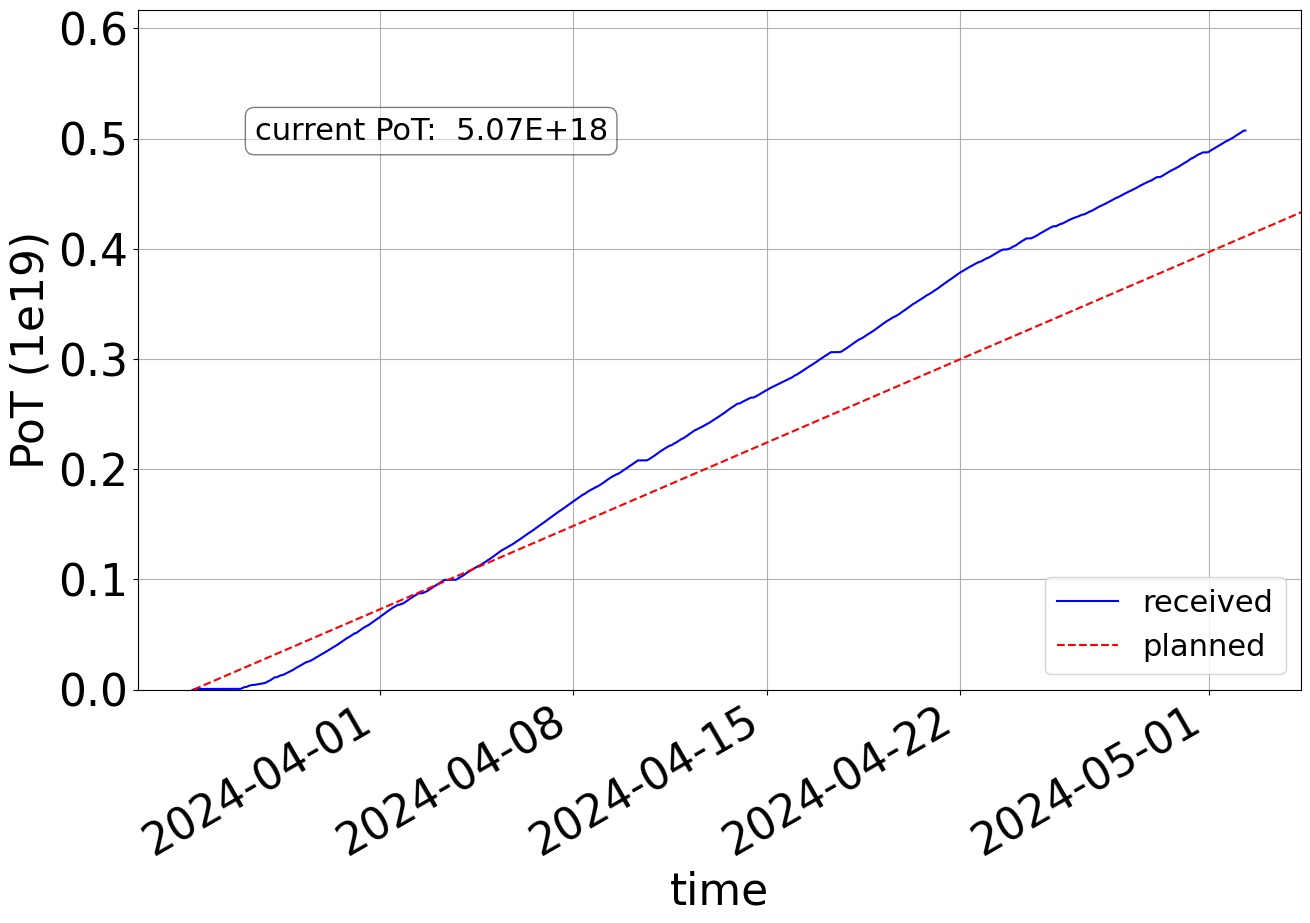
East Area Beam Status (B. Raë)
No major issues. Small issue on Monday night on the Beam stopper that didn’t affect the beam availability.
On call number: 67500
T09: Normal operation. Low momentum configuration was done on 30th April for PAN. Next week for Straw the low-pressure threshold cherenkov and the XBPFs and XSCIs will be put back keeping the high-p XCET un-installed to reduce the material for their low momentum beam.
T10: Good operation.
T11: No operation/no user.
East Area Users Tour de Table
T8 Main: IRRAD/CHARM (F. Ravotti / S. Fiore)
Regular user operation. Good week, cumulated ~2.2e16 p/w on T8, see plot below. Problem with beam trajectory on Thursday morning ~6:45 due to issues with the T8 stabilizer tool being commissioned since the day before.
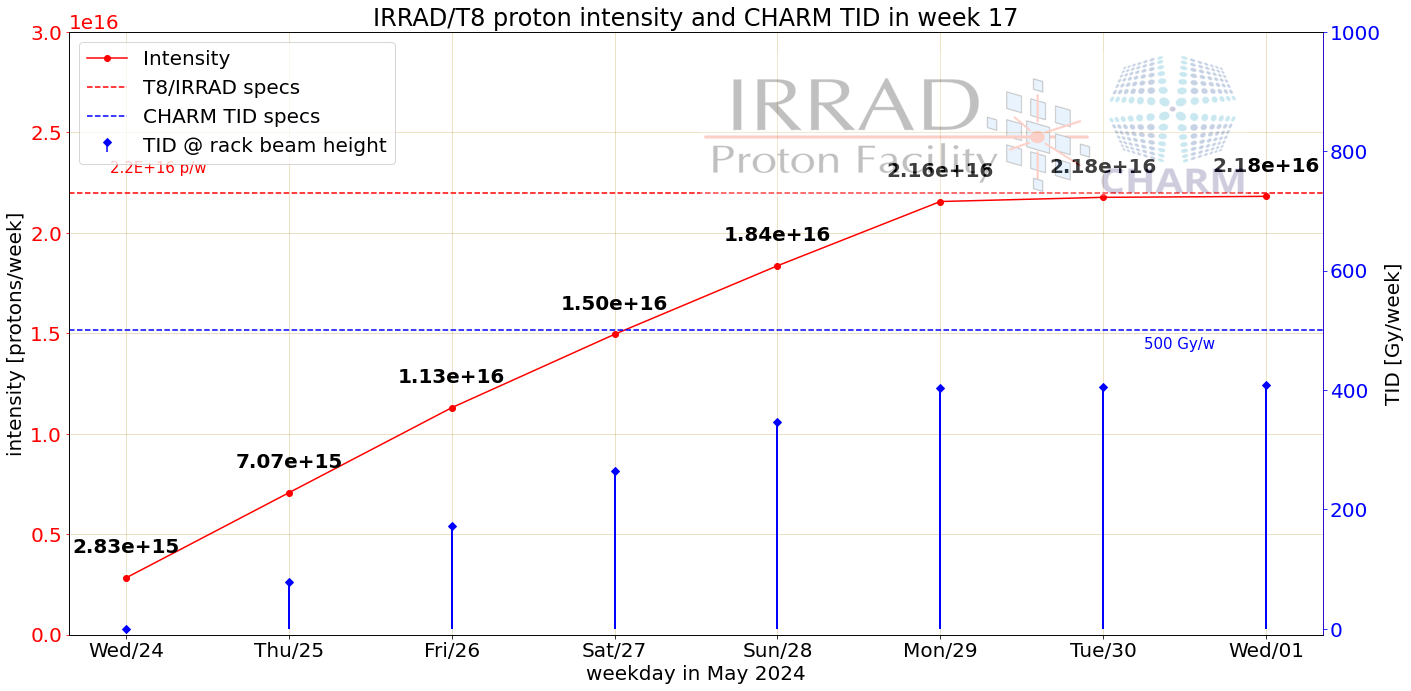
Despite the issue, good beam steering during week 17 (center within +/- 2mm >90% of the time on both axis):

Beam stop on Monday night to be able to access on Tuesday (holiday on Wednesday) in parallel with EA1 access at lunch time. About Tuesday access: in IRRAD, exchanged the dosimetry for the ongoing experiments and added complex on-line experiment for TE-CRG (see pictures below). For CHARM, >400 Gy delivered at the reference dosimeter during last week. Fast access to change daughterboards on BE-CEM-EPR new test setup, with no movement of rack. Good planning and design of the setup allowed to finish with 1/20 of the average dose to personnel. Beam back in the afternoon around 4pm with reduced intensity as requested by the TE-CRG experiment. Nominal intensity from Wed. around 10am. We continue running until next week on Wednesday.
**TE-CRG experiment in IRRAD: **
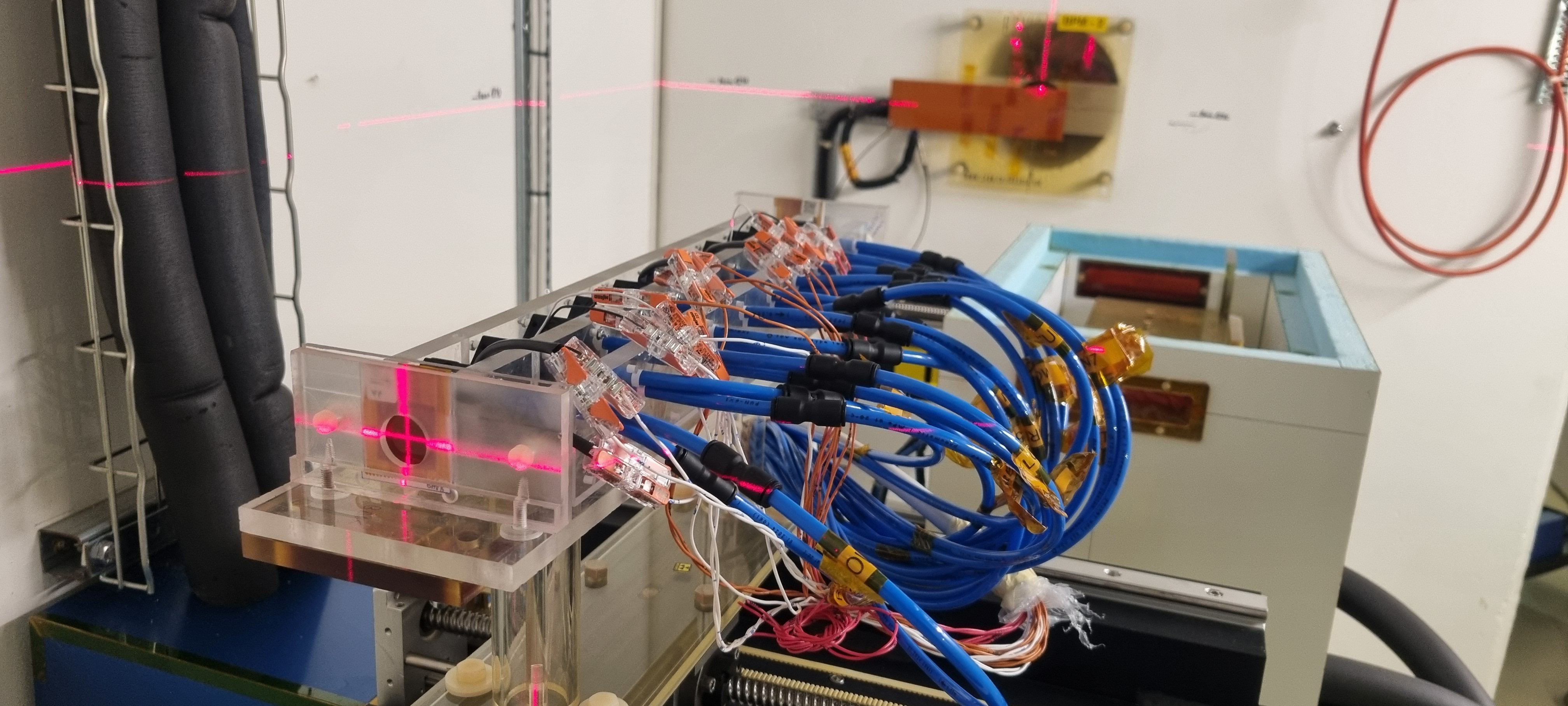
**Control unit in IRRAD technical area: **

T9 Main: PAN (Johannes Hulsman)
MiniPAN
MiniPAN was placed and set up on Wednesday afternoon and Thursday morning. We passed safety on April 25th. However, we only started taking data on Friday as one of the readout boards was faulty and needed to be replaced.
On April 29 the readout was replaced by a better one.
PixPAN
The PixPAN sensor we are testing has been mostly operating without issues. Valueable data was collected.
Scint. and Cherenkov Detectors
Tuesday, 30th of April, the instrumention for the scintillators and cherenkov detectors were removed. A vaccuum pipe was placed instead. This is in agreement with the discussion we had before to improve the beam quality for the second week.
Beam Configurations
So far: 0.1, 0.5GeV, 1GeV, 2GeV hadrons
Planned this week: 0.1GeV, 0.15GeV, 0.2GeV, 0.3GeV, 1GeV, 5GeV electrons
T9 Incoming Main: STRAW TRACKER RD (Week 19) (Temur Enik, Katerina Kuznetsova)
- beam settings under discussion with Dipanwita (many thanks for detailed mails)
- preparation of a simplified setup is ongoing (2 straws + timepix4 + scintillator)
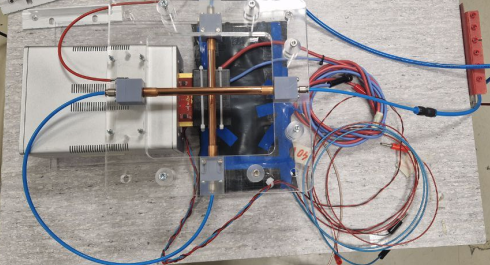
T10 Outgoing Main: ALICE TIMING (Sofia Strazzi)
- Succesful beam test > a lot of data to be analysed
- The new electronic chain (LIROC + pTDC) was tested for the first time with many different types of sensors (CMOS LGAD, SiPMs with different resins, single/double LGAD)
T10 Main: MEDIPIX (Benedikt Bergmann)
We have taken over the beam on Tuesday from Alice Timing. Safety visit was done on Tuesday at 17:00. Patrol training done, not sure if we have gotten the patrol right just yet.
Measurements have started around 18:00. We have been running with hadrons positive polarity 10 GeV/c momentum for the entire day yesterday without problems.
Picture of the setup:
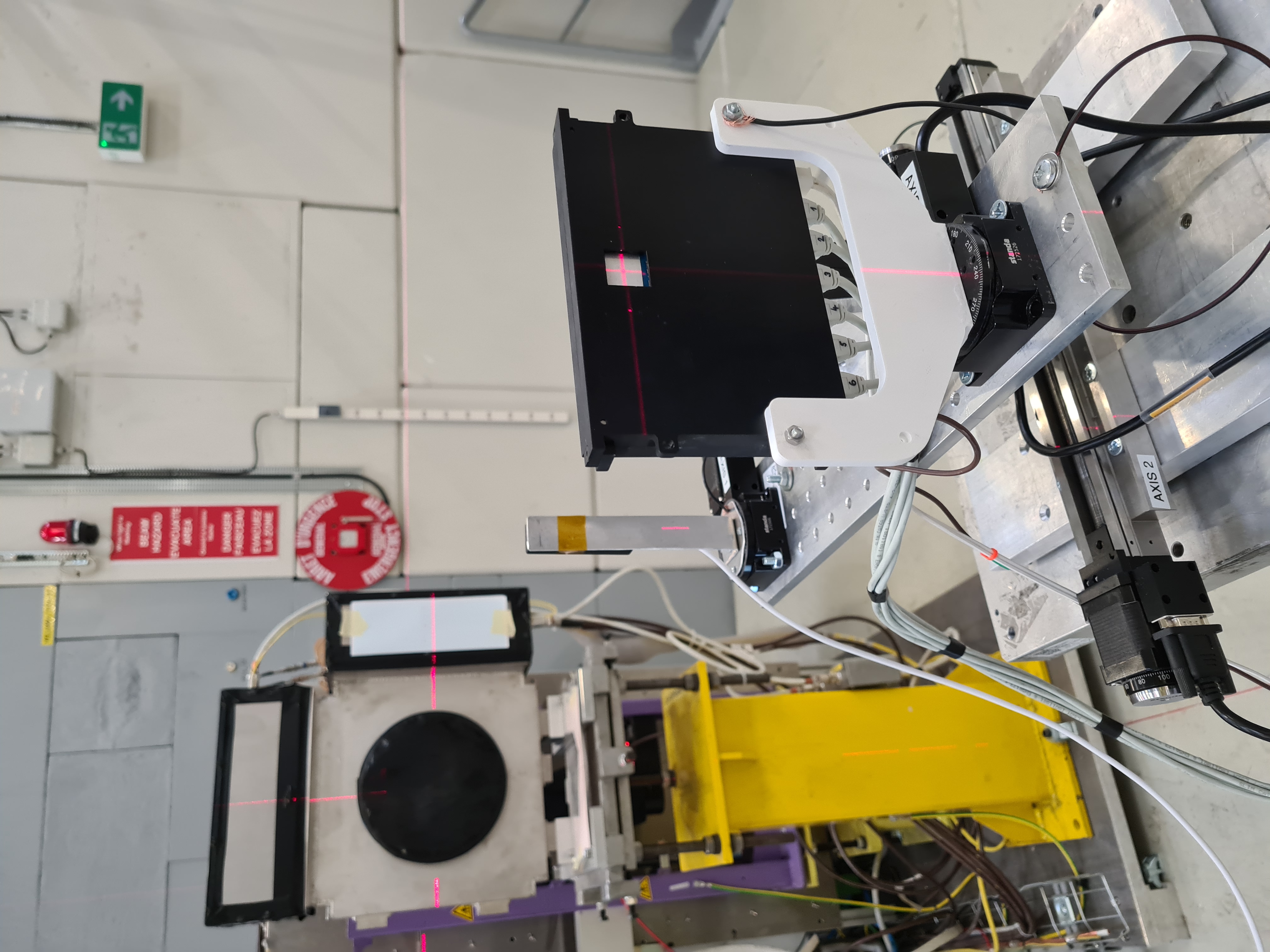
Measurements done
- Detector control software testing, mainly testing of online analysis (performance of parallel clustering)
- Test of miniature Timepix2 - adjusting paramters to optimize measurement parameters, now implementing some novel features to the FW
- ATLAS/MoEDAL two-layer Timepix3 unit: single-layer particle tracking capability as a function of the impact angle. - started; will be continued.
Next measurement @ 10 GeV/c momentum:
- Evaluation of Timepix2 for continuous measurement in continuous read/write
- Characterization of the GaAs:Cr, LGAD and SiC sensors on Timepix3
Momentum change to 3 GeV/c foreseen for Monday - if everything goes according to the plan.
T10 Incoming Parallel: ALICE FOCAL (Week 19) (Please Put Your Name Here)
T10 Incoming Main: ALICE ITS3 (Week 19) (Paolo Martinengo)
Preparing to install as scheduled
We may be interested in staying also in week 20
AWAKE (M. Bergamaschi)
Last week summary
Proton beam: On Monday good delivery from SPS, Tuesday -Friday few extractions because of issue with injectors and LHC fills, Saturday-Sunday good delivery
| |
M |
T |
W |
Th |
F |
S |
S |
| SPS extration |
1278 |
378 |
MD |
450 |
561 |
1083 |
1125 |
| Hours of beam to AWAKE |
9.5 |
3.1 |
MD |
4.9 |
4.4 |
6.7 |
6.9 |
Detailed program of last week:
- Monday: Studies of self modulation transition at different bunch population (3e11 and 1e11 p/bunch) at plasma density 1.93e14 1/cc
- Tuesday: Started studies at bunch population of 2e11 p/bunch
- Wednesday: Access to realign laser virtual line, plasma light diagnostic calibration
- Thursday: Effect on plasma light diagnostics of low bunch populations (0.5 and 1e11 p/bunch) with RIF scans, plasma density 3.8e14 1/cc. Investigation the effect of a density step, ChDr BPM studies
- Friday: Effect on plasma light diagnostics of low bunch populations (0.5 and 1e11 p/bunch) with RIF scans, plasma density 1.9e14 1/cc. Investigation the effect of a density step, ChDr BPM studies
- Saturday: Studies on e-spectrometer with laser dump in and out with electron acceleration at plasma density 6.2e14 1/cc
- Sunday: Density gradient studies with 0.5e11p/bunch at 1.9e14 1/cc and Self modulation studies at 3.8e14 1/cc with bunch 2e11 p/bunch
Next run starting the 20th of May
HiRadMat (N. Charitonidis)
HRMT-64 experiment advancing well, dedicated & parasitic teams taking beams. Many thanks to the flexibility by PSB/PS & SPS for extremely fast adaptation to the various beams requests (type, intensity & emittances)!
North Area Beam Status (B. Raë)
Proposed target sharing
| Target |
Units (1e11) |
Comment |
| T2 |
100 |
NA64e |
| T4 |
40 |
T10/NA62 defines T4 intensity |
| T6 |
50 |
|
| T10 |
20 |
|
Next change in week 21.
General: Smooth operation.
On call number: 67500
H2: Alice Phos installed and take Data. Good operation.
H4: Good operation, vacuum transformation for NA64e
H6: A few radiation warnings on Saturday night but these were safe and the intensity was reduced a little on Sunday. Otherwise, no issues. CERF changeover this morning - reminder: no downstream access this week even when beam off briefly.
H8: Good operation.
M2: No major issues.
P42/K12: Good operation. Routine re-steering to T10 done after transmission dropped slightly.
North Area Users Tour de Table
P42-K12:
Main: NA62 (Renato Fiorenza)
Some instabilities in both beam intensity and in beam oscillations, see attached slides. This morning the situation improved very much. Otherwise data taking is proceeding smoothly.
M2:
Main: AMBER (Thomas Poschl)
- Friday: dismantling of Cedar 089 and transport to EHN1
- In-situ checks in clean room ongoing.
- Implementation and cabling of liquid-hydrogen target ongoing
- In parallel, commissioning of rest of spectrometer ongoing. No significant issues and ready for data taking
- Empty-target measurements and tomography-measurements of target cell planned for upcoming week

subsequent filing of minutes for last meeting (25/04/24):
- Ecal calibration finished
- water flooding in building 891 from the drain water of the pumping of the underground galleries. No damage found
- liquid-hydrogen target delivered and aligned
- control system faces delays due to delays in delivery times of required components
- investigation of the issues with Cedar 089 and decision to move cedar back to clean room in EHN1 for check and repair.
H2:
Main: ALICE PHOS (Mikhail Ippolitov)
Transport, installation and safety clearance were done on 29.04. The detector was stabilized at T=+16.5. The beam line was prepared by noon on 30.04. Until 8-00 02.05 energy scans at +16.5 were finished and cooling started. We expect -25C at 03.05. late in the evening. The beam was very good. We took a lot of good data. As example, here very nice linearity curve(online data). Deviation 0.087@150 GeV.
,
H4:
Main: NA64e (L. Molina Bueno)
We completed installation last Friday and we started commissioning a calibration this week. A brief presentation summarises the activities carried out
H6:
Outgoing Parallel: MONOLITH (Lorenzo Paolozzi)
- Good data taking for all week: very high intensity, the parameters are ideal for future high-intensity runs.
- We have other two weeks of high intensity scheduled, ideally we would like to stay in the area to keep the alignment and save resources.
- There are approximately 3m avaiable between AIDA telescope and our setup. Question for CMS MTD: is it enough space to install your setup?

Outgoing Main: EP PIXEL (Dominik Dannheim)
- Very efficient high-intensity data taking thanks to excellent beam tuning by Laurie and smooth collaboration for accesses with MALTA and MONOLITH.
- Achieved rates of approximately <~5E6 / spill in scintillator 532.
- Took data for H2M pixel-detector sample. Various parameter scans (bias voltage, several chip settings). Thanks to extra day of beam time yesterday, we were also able to already start angular scans.
- Keeping telescope setup in standby until next high-rate beam time end of May, where we will continue the parameter scans and test also a different sample.
Main: CERF (Robert Froeschl, Fabio Pozzi, Marco Tisi)
- CERF is starting today
- roof is being removed and beam dump is being installed
- Please do not access the H6 areas downstream CERF (warning signs have been put on the access doors of the affected areas)
Parallel: ATLAS MALTA (Anusree Vijay, Tomohiro Inada, Carlos Solans)
- Telescope set up ready and started taking data since Tuesday.
- Linear stage and alignment issues fixed.
- Need to take data for rotational measurements for few configurations.
- We would like to use the parasitic beam time for these measurements after the high intensity time to avoid radiation damage.
Incoming Main: ATLAS HGTD (Week 19) (Stefano Manzoni and Djamel Boumediene)
HGTD testbeam from 08/05 to 22/05 (then from 29/05 to 12/05)
Aim of the testbeam measurement of performance of module (LGADS+ASIC) and individual LGAD
- module/LGAD bias up to 500 V
- time reference using MCP with a bias of 2.5kV
Beam request: pions at ∼120 GeV, 1-2 cm2, intensity ∼10k particles/spill
H6A (PPE-146) material:
- Cold box (on igus stage) + telescope (Aconite)
- FEI4
- Chiller + Nitrogen
- Readout in NI-crate
Expected installation and commissioning time about 1-1.5 day
ISIEC submitted today befor the meeting
Incoming Parallel: RE1 AMS L0 (Week 19) (INFN-Perugia: Matteo Duranti, matteo.duranti@infn.it, Gianluigi Silvestre)
Purpose: measure the spatial resolution (+ the efficiency under the bias resistor region) of the first flight models built for the upgrade (Layer 0, L0) of the AMS-02 experiment on the International Space Station
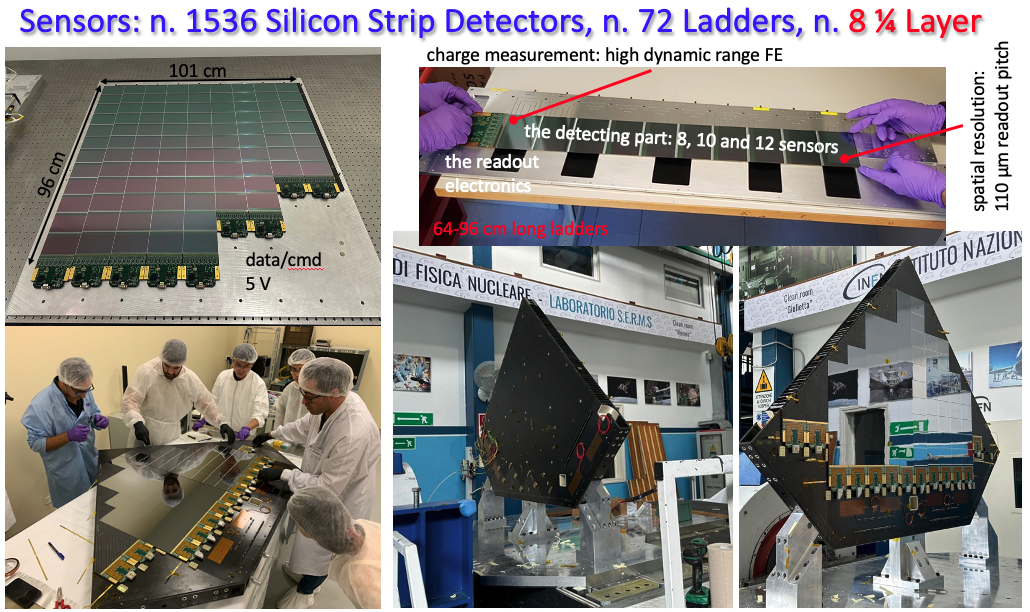
- long modules (~ 1 m)
- daisy chain of “wide” (8 ×
12 cm2) Si μ
- strip sensors;
- total of ~ 7 m2
-
- 72 to build in total, more than 40 already built
- to be lunched in space End 2025 / Beginning 2026
- to be installed Beginning 2026
Beam:
- our setup can sustain (without significant pile-up) up to ~ 1 KHz;
- given the low rate behind the beam dump we’ll stay for 3 weeks;
- on the contrary a “wide” (sigma = few cm) would be ideal;
- every kind of Z=1 (resolution is much different for higher charge particles) particle is good: muons are perfect;
Setup:
- sketch
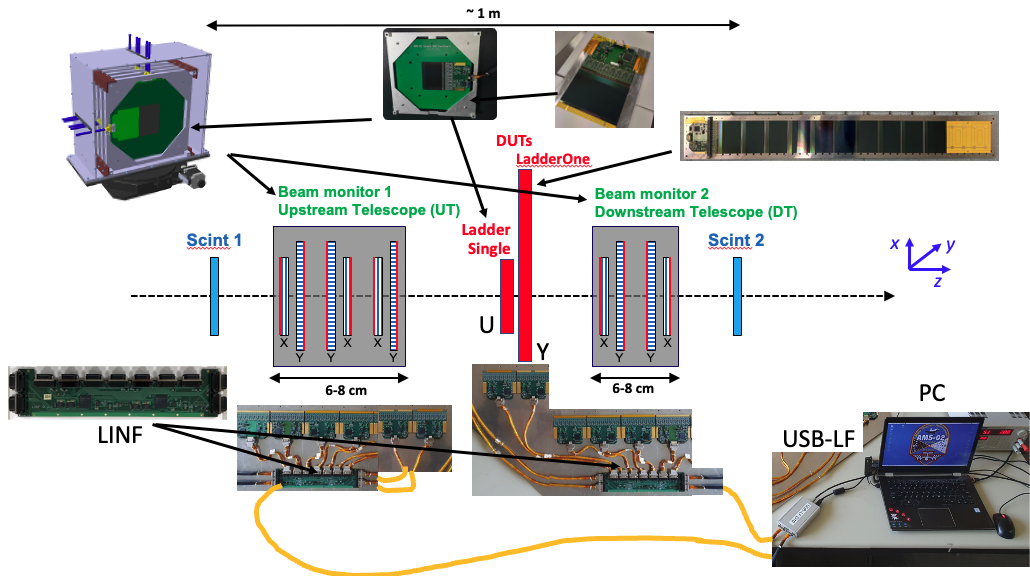
- pictures from last year (ions)
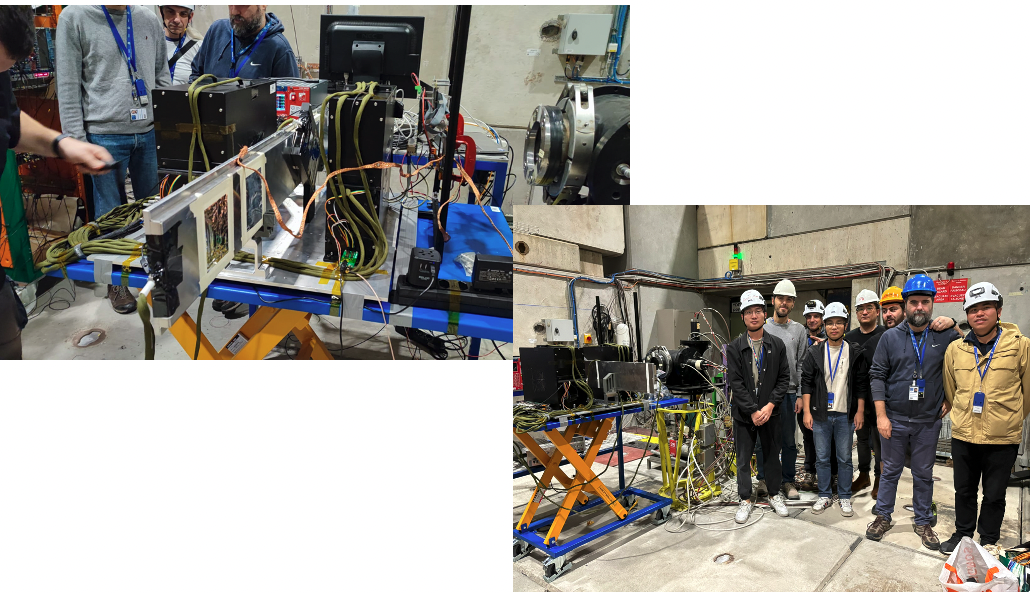
Logistics (PPE 166):
- a couple of “standard” tables/desk for the DUT and for the DAQ (electronics, PCs, etc…)
- the CERN network
- electric power
a spill-in/spill-out cable --> we’ll do withouta control room --> an office would be ok (no need for CESAR, right?)- crane (1 basket movement at the begin and at the end)
- ISIEC document created (ID: 1244)
- “experiment” form on asm.cern.ch filled
- crane request not yet done
Incoming Parallel: CMS MTD ETL (Week 19) (Giacomo Zecchinelli)
- Test beam from May 8th to 15th
- Aim of the test beam is to characterize the timing performances of the ETL LGADs sensor + ETL FE
- ISIEC submitted yesterday, asking for safety inspection on May 8th at 16:00
- Our setup will be mounted in a cold box that will fit in the AIDA telescope of H6 156
- LGAD sensors bias between 200 - 350 V
- We will trigger the AIDA telescope and the ETL modules with an MCP mounted at the end of the telescope
- MCP bias up to 4kV
- After initial comissioning we don’t expect frequent interventions
- The ETL modules will be kept at constant temperature (10 Celsius) using a water based chiller
-
Incoming Parallel: ATLAS BCM PRIME (Week 19) (Please Put Your Name Here)
H8:
Main: LHCb (Please Put Your Name Here)
Parallel: LHCb SciFi (Federico Ronchetti)
- Smooth operation of the DAQ and we finished all our high priority measurements.
- We moved to mid priority measurements and further tests to compare with simulations.
- We thank a lot Maarten and the other LHCb groups upstream on the line for the continuos communication :)
- Just a hiccup in intesity during the weekend and the first days of the week: low intensity than last week.
- Beam in PPE168 has sizes < 2 cm in the orizontal plane and > 10 cm in the vertical one, that suits our trigger selection to cover the whole fibre mat that we are testing in the verical direction.
- In week 20 there is no main user on H8, we would like to be if possible.
Incoming Main: UA9 (Week 19) (F. Galluccio)
UA9 will start installing on Wednesday the 8th, as soon as the beam pipes will be removed.
This year we will run with 6-plane tracker and will have a timepix3 as extra beam monitor; this run will be mainly dedicated to the commissioning of the detector in the new configuration.
I will contact M. Lazzaroni to specify which beam pipes to open and to know at what time we can start installing.
ISIEC is being submitted.
Still big conflict (UA9 and MUONE at the same time) in Autumn draft plan.
Parasitic Users
H8: STRAW TRACKER RD (Temur Enik, Katerina Kuznetsova)
- safety kindly agreed to the discussed ISD option, safety visit is being scheduled (slightly delayed by the StrawTracker team due to ongoing preparation for the PS run)
H8: CMS PPS (F. Garcia)
The setup has been installed and consists of three platforms: The Rerence tracker, the psQ together with the Q-Fib and the trigger together with the irradiated Diamond box.
All the connections and installation has been carried out in a series of access agreed with the SciFi group with whom we share the same experimental area.
For the time being being we are waiting for the Safety inspection today around 15:30 then afer we will start to alignment of the detectors. The ISIEC was submitted on last Monday and I am waitinf for confirmation.
So far the beam conditions are not the best, but to have some coarse calibration is fine, however for data taken most probable no. The issue is the beam spot which is has very large dispersion in the vertical plane.
We expect that once the system is ready for taking data then we start to negotiate some shifts for data taken.
Everythig is working fine and no major issues to report has been encountered. Many thanks to all the teams of the NA for your support and also for the teams in the H8 line for their cooperation.
H8 Incoming: LHCB (Week 19)
AoB
Minutes by the respective speakers, edited by E. B. Holzer, M. Jaekel, T. Shulha, and M. Schwinzerl












